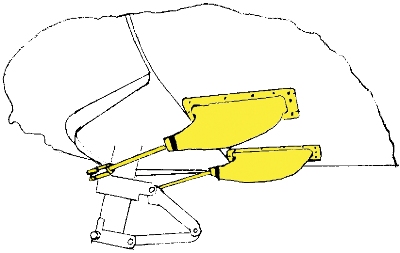Part Number: MC0543022-2
TUBE STEERING (Right)
Eligibility Notice
Please verify that this product is eligible for your aircraft before adding
it to your cart.
Click here to view product eligibility.
Click here to view product eligibility.
Product Details
Stainless steel tubes for improved corrosion resistance.
Nose Wheel Steering Rods for Cessna Aircraft
Tired of "soft" worn out steering rods?
Replace them with improved McFarlane FAA-PMA approved steering rods!
- New re-designed long-life springs
- Hardened internal washer for greater durability
- Stainless steel tubes for improved corrosion resistance (MC0543022 Series)
- Optimum performance even after years of service!

Can You Stop Nose Gear Shimmy? by Dave McFarlane
Steering Rod Boots also available!

Maintenance Tip!
How do I know if my steering rods need to be replaced?
- Nose wheel steering is unusually sluggish
- One or both sides offer little or no spring resistance to steering input
- More than 1 1/8" of free travel is present in either steering rod
- The aircraft pulls to either side during taxiing
- Inconsistent steering or rudder rigging
Supersedures
Eligibility Notice
Please verify that this product is eligible for your aircraft before adding
it to your cart.
Click here to view product eligibility.
Click here to view product eligibility.
| OEM Part Number | McFarlane Part Number | Comment |
| 0543022-12 | MC0543022-2 | |
| 0543022-2 | MC0543022-2 | |
| 0543022-8 | MC0543022-2 | |
| MC0543022-2C | MC0543022-2 |
Related Categories
Eligible Aircraft
| Make | Series | Model | Beginning S/N | Ending S/N | Eligibility Chart |
| Cessna | 172 | 172 | 28000 | 46754 | 1005 |
| Cessna | 172 | 172A | 46755 | 47746 | 1005 |
| Cessna | 172 | 172D | 17249545 | 17250572 | 1005 |
| Cessna | 172 | 172E | 17250573 | 17251822 | 1005 |
| Cessna | 172 | 172F (T-41A) | 17251823 | 17253392 | 1005 |
| Cessna | 172 | 172G | 17253393 | 17254892 | 1005 |
| Cessna | 172 | 172H (T-41A) | 17254893 | 17256512 | 1005 |
| Cessna | 172 | 172I | 17256513 | 17257161 | 1005 |
| Cessna | 172 | 172K | 17257162 | 17259223 | 1005 |
| Cessna | 172 | 172L | 17259224 | 17260758 | 1005 |
| Cessna | 172 | 172M | 17260759 | 17267584 | 1005 |
| Cessna | 172 | 172N | 17267585 | 17274009 | 1005 |
| Cessna | 172 | 172P | 17274010 | 17276673 | 1005 |
| Cessna | 172 | 172Q | 17275869 | 17276516 | 1005 |
| Cessna | 172 | 172R | 17280001 | 999999999 | 1005 |
| Cessna | 172 | 172S | 172S8001 | 999999999 | 1005 |
| Cessna | 172 | F172D | F1720001 | F1720018 | 1005 |
| Cessna | 172 | F172E | F1720019 | F1720085 | 1005 |
| Cessna | 172 | F172F | F1720086 | F1720179 | 1005 |
| Cessna | 172 | F172G | F1720180 | F1720319 | 1005 |
| Cessna | 172 | F172H | F17200655 | F17200754 | 1005 |
| Cessna | 172 | F172H | F1720320 | F1720431 | 1005 |
| Cessna | 172 | F172H | F1720432 | F1720435 | 1005 |
| Cessna | 172 | F172H | F1720436 | F1720442 | 1005 |
| Cessna | 172 | F172H | F1720443 | F1720443 | 1005 |
| Cessna | 172 | F172H | F1720444 | F1720446 | 1005 |
| Cessna | 172 | F172H | F1720447 | F1720654 | 1005 |
| Cessna | 172 | F172K | F17200755 | F17200804 | 1005 |
| Cessna | 172 | F172L | F17200805 | F17200904 | 1005 |
| Cessna | 172 | F172M | F17200905 | F17201514 | 1005 |
| Cessna | 172 | F172N | F17201515 | F17202039 | 1005 |
| Cessna | 172 | F172P | F17202040 | F17202254 | 1005 |
| Cessna | 172 | FP172 | FP1720001 | FP1720003 | 1005 |
| Cessna | 172 | FR172E | FR17200001 | FR17200060 | 1005 |
| Cessna | 172 | FR172F | FR17200061 | FR17200145 | 1005 |
| Cessna | 172 | FR172G | FR17200146 | FR17200225 | 1005 |
| Cessna | 172 | FR172H | FR17200226 | FR17200350 | 1005 |
| Cessna | 172 | FR172J | FR17200351 | FR17200559 | 1005 |
| Cessna | 172 | FR172J | FR17200562 | FR17200590 | 1005 |
| Cessna | 172 | FR172K | FR17200591 | FR17200675 | 1005 |
| Cessna | 172 | P172D | P17257120 | P17257188 | 1005 |
| Cessna | 172 | R172K | R1722000 | R1723454 | 1005 |
Related Documents
Press Releases
| 2013-09-24 Can You Stop Nose Gear Shimmy? |
PMA Lists
| McFarlane Aviation, Inc. PMA Supplement 1 |
Maintenance and Product Guides
| Can You Stop Nose Gear Shimmy? |
Installation, Use, and Maintenance Instructions
| Steering Rod Boot Installation Instructions |
Eligibility Charts
| ELIGIBILITY, Steering Tube, Cessna 150, 152, 172 |
Related Product Catalog Pages
| Nose Wheel Steering Parts |
Frequently Asked Questions
Related Items
Please verify product details for suitability for your application.
 WARNING: Cancer and/or Reproductive Harm - www.P65warnings.ca.gov
WARNING: Cancer and/or Reproductive Harm - www.P65warnings.ca.gov







